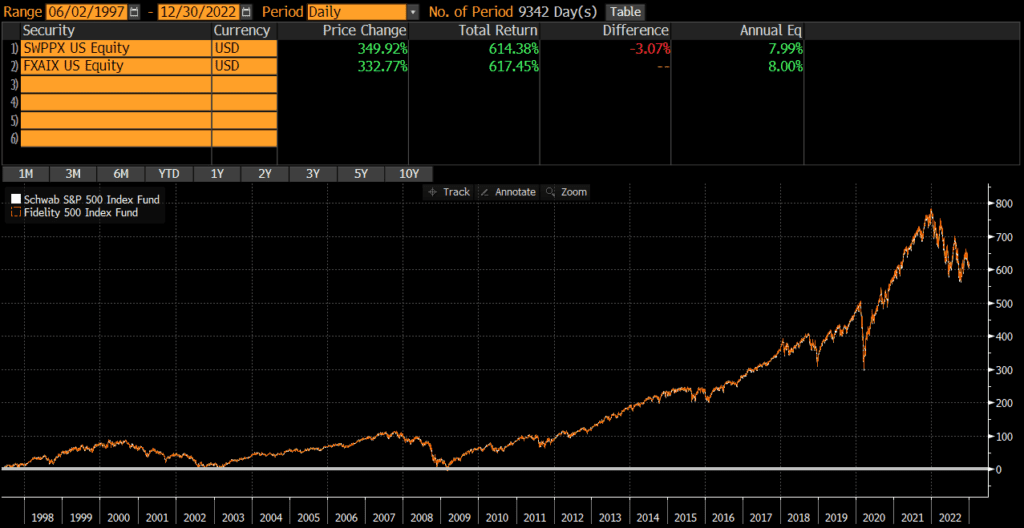The Schwab S&P 500 Index Fund (SWPPX) and the Fidelity S&P 500 Index Fund (FXAIX) are two of the largest S&P 500 index mutual funds in existence and easily two of the most popular among individual investors. Both SWPPX and FXAIX track the well-known S&P 500 index and form the core of many investor portfolios. Many investors compare SWPPX vs FXAIX in order to decide which should be the foundation of their portfolio.
A quick reminder that this site does NOT provide investment recommendations. Fund comparisons (such as this one) are not conducted to identify the “best” fund (since that will vary from investor to investor based on investor-specific factors). Rather, these fund comparison posts are designed to identify and distinguish between the fund details that matter versus the ones that don’t.
The Short Answer
There are not many differences between SWPPX and FXAIX. Therefore, investors should consider factors beyond the underlying portfolios (which are essentially identical) in order to decide which fund is best for them.
The Long Answer
Historical Performance: SWPPX vs FXAIX
FXAIX was launched 1988, while SWPPX was launched in May 1997. Since their common inception date the two funds have performed identically, with a difference of just .01% annually! The cumulative performance difference between these two funds has been just over 3% (over a 25 year timeframe)! Thus, from a performance perspective, I would consider these two funds interchangeable.

Differences between SWPPX vs FXAIX
Both SWPPX and FXAIX track the S&P 500, so I will not delve into differences in geographic exposures, sector weights, or market cap coverage. For all intents and purposes, the portfolios are identical with 504 stocks each. The S&P 500 has more than 500 stocks because of the index constituents have multiple share classes of stock (such as GOOG and GOOGL).
Factors to Consider
Expenses
Some investors may point out that the expense ratios between SWPPX and FXAIX differ. This is true, but at a certain level, differences in expense ratio do not matter that much. In this case, the SWPPX’s expense ratio of .02% is 33% higher than the expense ratio of FXAIX’s .015%. However, we’re talk about half a basis point (or .005%), so even though SWPPX is 33% more expensive than SWPPX, its inconsequential.
Transaction Costs
Many brokers and custodians still charge commissions and/or transaction fees to buy/sell mutual funds. To my knowledge, Schwab does not participate in the pay-to-play arrangements (with their competitor custodians) that would allow their mutual funds to trade for free on many platforms. So if an investor account is at Schwab, it is generally free to trade SWPPX.
Similarly, Fidelity does not participate in pay-to-play arrangements, so FXAIX trades are likely to incur a fee at any custodian besides Fidelity.
Investors looking for free trades may want to consider an S&P 500 ETF, such as VOO, SPY, SPLG, or IVV.
Tax Efficiency & Capital Gain Distributions
Both funds are relatively tax-efficient, since they are index funds. However, they both regularly make capital gains distributions and I would expect this to continue. Investors looking for a more tax-efficient vehicles of taxable accounts may want to consider using an ETF.
Tax Loss Harvesting
Investors may want to avoid using these two funds as tax loss harvesting substitutes for one another since they could be considered “substantially identical.”
Tradability
Neither FXAIX nor SWPPX have a stated minimums for purchases, although some brokerages (especially competitors of Schwab/Fidelity) impose minimums. Again, using an ETF equivalent of either of these funds may make sense.
Final Thoughts: SWPPX vs FXAIX
Both SWPPX and FXAIX are large, core funds sponsored and managed by Schwab and Fidelity respectively. Performance has been nearly identical. I view these two funds as essentially interchangeable and would not spend too much energy trying to decide which one is “better.”
However, there are some situations that may call for one fund versus another. So I might select SWPPX or FXAIX solely based on where my account is held. Despite these considerations, these two funds are very similar for all intents and purposes.